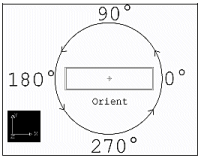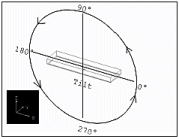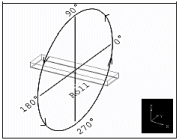Appendix E - IES Luminaire Aiming Angles
Standardized luminaire aiming angles are described in IES document LM-72 available from www.ies.org. These angles are not utilized in ElumTools directly, but may be helpful when positioning the lightsource while building luminaire families.
| Orient - Orient is applied counterclockwise about the Z-axis. Looking toward -Z (downward), the +X axis tends toward +Y. This is a positive Orient angle. Orient=0 places +X due east. Orient is always the first aiming angle applied when multiple aiming angles are specified. Note that before any aiming is applied the Global and Local coordinate systems are aligned.
Example: In Plan View (looking down on the luminaire), Orient=0 points the zero-degree horizontal plane of photometry due east. Orient=45 is 45 degrees counterclockwise from there, which is northeast. Typically, for most luminaires the zero-degree horizontal plane of photometry points out the front of the luminaire or in the primary direction of the light distribution. An exception to this rule is quadrilaterally symmetric fluorescent photometry where 0H is parallel to the lamps as shown in our illustration.
|

|
| |
|
| Tilt - Tilt is applied about the local Y-axis. Looking toward +Y, local -Z tends toward local +X. This is positive Tilt. Tilt=0 aligns photometric nadir and zenith with the Z-axis. Tilt is the second aiming angle applied when positioning a luminaire.
Another way to picture this is to begin with the luminaire aimed straight down (Tilt=0). Now look in the direction of the front of the luminaire. A positive tilt will bring the aiming vector of the luminaire up in that direction. If you are looking east (Orient=0), a positive tilt will bring photometric nadir up toward the east.
Example: A Tilt angle of 90 degrees (and Orient=0) will point photometric nadir due east at the horizon. Likewise, with Orient=90 and Tilt=90 the luminaires photometric nadir will point north at the horizon.
|

|
| |
|
| Roll - Roll is applied about the local X-axis. Local -Z tends toward local +Y. This is a positive Roll angle. The Roll angle is the third aiming angle applied in succession.
Example: With Orient=0 and Tilt=0, a Roll angle of 90 degrees will point photometric nadir due north at the horizon by rolling the luminaire to its right. This effectively stands the luminaire on its side
|

|
| |
|
| Spin -Spin is applied about the local Z-axis. With a positive Spin, +X tends toward +Y. A positive Spin is then identical to Orient when no other angles are applied. However, once a Tilt or Roll has been applied, the Spin angle operates in the Local coordinate system, whereas the Orient angle continues to act Globally.
Example: With Orient=0 and Tilt=45 (applied before Spin), a Spin angle of 45 degrees will then rotate the luminaire about the local Z-axis by 45 degrees. This effectively "leans" the luminaire's photometric distribution 45 degrees to its left.
|

|
| |
|




